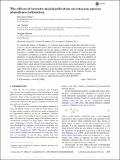Files in this item
The effects of acoustic misclassification on cetacean species abundance estimation
Item metadata
| dc.contributor.author | Caillat, Marjolaine Annie | |
| dc.contributor.author | Thomas, Len | |
| dc.contributor.author | Gillespie, Douglas Michael | |
| dc.date.accessioned | 2014-08-14T16:01:01Z | |
| dc.date.available | 2014-08-14T16:01:01Z | |
| dc.date.issued | 2013-12-25 | |
| dc.identifier | 50918198 | |
| dc.identifier | 8819af3f-9c5a-4150-813d-7b50a7394bae | |
| dc.identifier | 84883331064 | |
| dc.identifier.citation | Caillat , M A , Thomas , L & Gillespie , D M 2013 , ' The effects of acoustic misclassification on cetacean species abundance estimation ' , Journal of the Acoustical Society of America , vol. 134 , no. 3 , pp. 2469–2476 . https://doi.org/10.1121/1.4816569 | en |
| dc.identifier.issn | 0001-4966 | |
| dc.identifier.other | ORCID: /0000-0002-7436-067X/work/29591686 | |
| dc.identifier.other | ORCID: /0000-0001-9628-157X/work/60427061 | |
| dc.identifier.uri | https://hdl.handle.net/10023/5163 | |
| dc.description | This work was funded through the Natural Environment Research Council and SMRU Ltd. | en |
| dc.description.abstract | To estimate the density or abundance of a cetacean species using acoustic detection data, it is necessary to correctly identify the species that are detected. Developing an automated species classifier with 100% correct classification rate for any species is likely to stay out of reach. It is therefore necessary to consider the effect of misidentified detections on the number of observed data and consequently on abundance or density estimation, and develop methods to cope with these misidentifications. If misclassification rates are known, it is possible to estimate the true numbers of detected calls without bias. However, misclassification and uncertainties in the level of misclassification increase the variance of the estimates. If the true numbers of calls from different species are similar, then a small amount of misclassification between species and a small amount of uncertainty around the classification probabilities does not have an overly detrimental effect on the overall variance. However, if there is a difference in the encounter rate between species calls and/or a large amount of uncertainty in misclassification rates, then the variance of the estimates becomes very large and this dramatically increases the variance of the final abundance estimate. | |
| dc.format.extent | 8 | |
| dc.format.extent | 948440 | |
| dc.language.iso | eng | |
| dc.relation.ispartof | Journal of the Acoustical Society of America | en |
| dc.subject | QH301 Biology | en |
| dc.subject.lcc | QH301 | en |
| dc.title | The effects of acoustic misclassification on cetacean species abundance estimation | en |
| dc.type | Journal article | en |
| dc.contributor.sponsor | NERC | en |
| dc.contributor.institution | University of St Andrews. Statistics | en |
| dc.contributor.institution | University of St Andrews. Marine Alliance for Science & Technology Scotland | en |
| dc.contributor.institution | University of St Andrews. Centre for Research into Ecological & Environmental Modelling | en |
| dc.contributor.institution | University of St Andrews. School of Biology | en |
| dc.contributor.institution | University of St Andrews. Scottish Oceans Institute | en |
| dc.contributor.institution | University of St Andrews. Sound Tags Group | en |
| dc.contributor.institution | University of St Andrews. Bioacoustics group | en |
| dc.contributor.institution | University of St Andrews. Sea Mammal Research Unit | en |
| dc.identifier.doi | 10.1121/1.4816569 | |
| dc.description.status | Peer reviewed | en |
| dc.identifier.grantnumber | NE/J020176/1 | en |
This item appears in the following Collection(s)
Items in the St Andrews Research Repository are protected by copyright, with all rights reserved, unless otherwise indicated.

